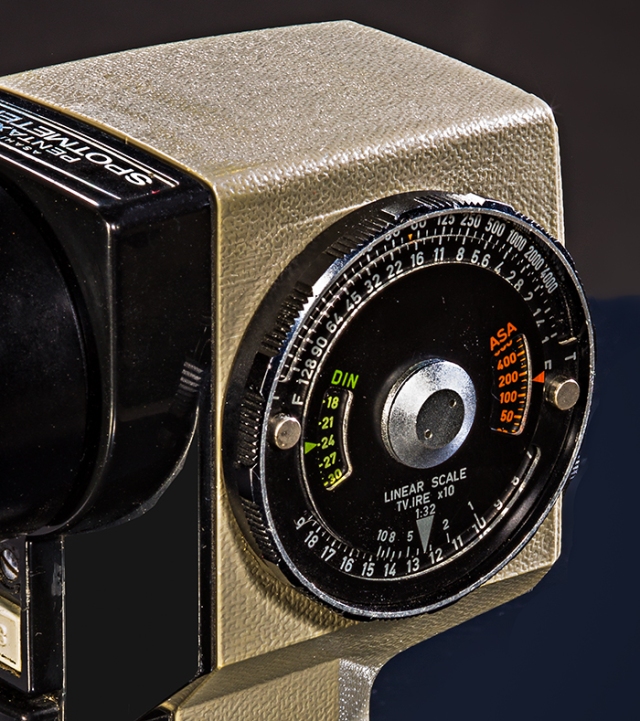Well, Spring 2017 semester is well underway and after preliminary calibration exercises to help students learn the abilities and limitations of their cameras, in the lighting class I did a demo for the 2nd shooting assignment: a Product that is solid with texture.
For this demo I decided to use my old Honeywell-Pentax V Spotmeter. I’ve misplaced my normal meter (Sekonic 508… which is driving me crazy trying to find it…) so brought out my backup meter and it seemed like a reasonable subject since the grip has a fine molded texture that is supposed to simulate a linen covering. It also is a very angular body so it helped to demonstrate the effect of lighting angles.
For the demo I put it in front of a black seamless and sat it on an old sheet of black acrylic to get the reflection. Unfortunately that poor old sheet of plastic needs polishing since it is heavily scratched and my poor old meter not only has some wear on it but in the studio the open ceiling just rains dust and dirt particles as the lights heat up and the thermals start swirling in the room. Dark surfaces REALLY show of the crud.
I used our Photogenic 320 WS lights set as noted in the light plot below. All used the standard 7” aluminum reflectors with no other modifiers. It was important to show that as wonderful as modifiers are, you can still make good photographs with normal, simple lights.
The camera is a Canon 5DSr with a Canon 85mm 1.8 lens at f16. Camera profile and lens correction were applied in ACR. Editing was completed in Photoshop.
Here is the light plot.

I also wanted to start showing the effects of different levels of editing/retouching so defined the shoot to serve two very different needs with one captured image. The first was an accurate shot for an Ebay- type sale and the other was a clean version for an editorial use in a publication talking about meter types.
Here is the initial version.

Remember one of the main stated goals was to be able to show the fine texture on the grip so here is a close up to see how the main light raked at a steep angle across that plane reveals the texture. Remember, texture is displayed by highlights and shadows.

For both needs the background and the scratched surface needed to be cleaned up so here is the shot with that done and as many dust mites as possible removed from the item. First we clean the meter.

Then we clean the background

This provides an honest view of the item’s condition that shows the scuffing on the handle from years of use but careful storage. But the distracting scratches and dirt on the plexi is removed.
And Finally we clean up the meter surface a little better for an editorial use which results in this final.

And that completes this demo. Next time we’ll tackle a different surface problem. By the way, this type of precision spot meter still has a major role to play in carefully crafted digital images. The Zone system is alive and well, just applied a bit differently than in the B&W film world.
